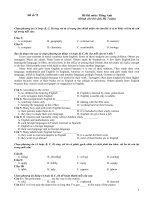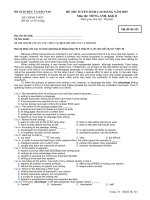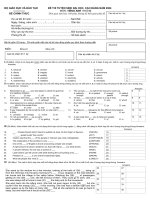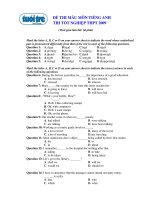Tài liệu Đề thi toán bằng tiếng anh 2012 pdf
Bạn đang xem bản rút gọn của tài liệu. Xem và tải ngay bản đầy đủ của tài liệu tại đây (117.71 KB, 7 trang )
Hanoi Open Mathematical Olympiad • • • www.hexagon.edu.vn
H
E
XAGON®
inspiring minds always
Hanoi Mathematical Olympiad 2012
Senior Section
1. Let x =
√
6+2
√
5+
√
6−2
√
5
√
20
. Find the value of (1 + x
5
− x
7
)
2012
311
2. Arrange the numbers p = 2
√
2
, q = 3, t = 2
1+
1
√
2
in increasing order.
3. Let ABCD be a trapezoid with AD parallel to BC and BC = 3 cm, DA = 6 cm. Find the
length of the line segment EF parallel to the two bases and passing through the intersection of
the two diagonals AC, BD, E is on CD, F on AB.
4. What is the largest integer less than or equal to 4x
3
−3x, where x =
1
2
(
3
2 +
√
3+
3
2 −
√
3).
5. Let f(x) be a function such that f(x) + 2f
x+2010
x−1
= 4020 −x for all x = 1. Find the value
of f(2012).
6. For every n = 2, 3, . . . , let
A
n
=
1 −
1
1 + 2
×
1 −
1
1 + 2 + 3
× ··· ×
1 −
1
1 + 2 + ··· + n
.
Determine all positive integers n such that
1
A
n
is an integer.
7. Prove that a =
1 . . . 1
2012
5 . . . 5
2011
6 is a perfect square.
8. Determine the greatest number m such that the system
x
2
+ y
2
= 1, |x
3
−y
3
| + |x − y| = m
3
has a solution.
9. Let P be the intersection of the three internal angle bisectors of a triangle ABC. The line
passing through P and perpendicular to CP intersects AC and BC at M, N respectively. If
AP = 3 cm, BP = 4 cm, find the value of AM/BN .
10. Suppose that the equation x
3
+ px
2
+ qx + 1 = 0, with p, q being some rational numbers, has
three real rooots x
1
, x
2
, x
3
, where x
3
= 2 +
√
5. Find the values of p, q.
11. Suppose that the equation x
3
+ px
2
+ qx + r = 0 has three real roots x
1
, x
2
, x
3
where p, q, r
are integers. :et S
n
= x
n
1
+ x
n
2
+ x
n
3
, for n = 1, 2, . . . ,. Prove that S
2012
is an integer.
Copyright
c
2011 H
E
XAGON
1
Hanoi Open Mathematical Olympiad • • • www.hexagon.edu.vn
12. Let M be a point on the side BC of an isosceles triangle ABC with BC = BA. Let O be the
circumcenter of the triangle and S be its incenter. Suppose that SM is parallel to AC. Prove
that OM ⊥ BS.
13. A cube with sides of length 3 cm is painted red and then cut into 3 × 3 × 3 = 27 cubes with
sides of length 1 cm. If a denotes the number of small cubes of side-length 1 cm that are not
painted at all, b the number of cubes painted on one side, c the number of cubes painted on two
sides, and d the number of cubes painted on three sides, determine the value of a − b − c + d.
14. Sovle the equation in the set of integers 16x + 1 = (x
2
− y
2
)
2
.
15. Determine the smallest value of the expression s = xy−yz−zx, where x, y, z are real numbers
satisfying the condition x
2
+ 2y
2
+ 5z
2
= 22.
2
Hanoi Open Mathematical Olympiad • • • www.hexagon.edu.vn
Solutions
1. Let x =
√
6+2
√
5+
√
6−2
√
5
√
20
. Find the value of (1 + x
5
− x
7
)
2012
311
Solution. Notice that 6 + 2
√
5 = (
√
5 + 1)
2
and 6 − 2
√
5 = (
√
5 − 1)
2
,
√
20 = 2
√
5 then
x = 1. That is
(1 + x
5
− x
7
)
2012
311
= 1.
2. Arrange the numbers p = 2
√
2
, q = 3, t = 2
1+
1
√
2
in increasing order. We have 2
1+
1
√
2
≥
2
1+
1
2
= 2
3
2
= 2
√
2.
Since
√
2 ≤
3
2
, then 2
√
2
≤ 2
√
2. Notice that
t
2
= 2
2+
√
2
≤ 2
2+
3
2
≤ 8
√
2.
Thus q
4
−t
4
= 81 −64 × 2 < 0. It follows that
p < t < q.
3. Let ABCD be a trapezoid with AD parallel to BC and BC = 3 cm, DA = 6 cm. Find the
length of the line segment EF parallel to the two bases and passing through the intersection of
the two diagonals AC, BD, E is on CD, F on AB.
Hint. Making use of the similarity of triangles. The line segment is the harmonic means of the
two bases, =
2
1
3
+
1
6
= 4. Let M be the intersection of AC and BD.
A D
CB
By the Thales theorem we get
OE
BC
+
OF
AD
=
OD
BD
+
OC
AC
=
OD
BD
+
OB
BD
= 1. From this,
1
OE
=
1
BC
+
1
AD
. Likewise,
1
OF
=
1
BC
+
1
AD
. Hence, OE = OF . That is,
2
EF
=
1
OE
=
1
BC
+
1
AD
=
1
3
+
1
6
=
1
2
. We get EF = 4 cm.
4. What is the largest integer less than or equal to 4x
3
−3x, where x =
1
2
(
3
2 +
√
3+
3
2 −
√
3).
Solution. By using the identity a
3
+ b
3
+ 3ab(a + b) = (a + b)
3
, we get
(2x)
3
=
3
2 +
√
3 +
3
2 −
√
3
3
= 4 + 6x.
Thus 4x
3
− 3x = 2. That is, the largest integer desired is 2.
3
Hanoi Open Mathematical Olympiad • • • www.hexagon.edu.vn
5. Let f(x) be a function such that f(x) + 2f
x+2010
x−1
= 4020 −x for all x = 1. Find the value
of f(2012).
Solution. Let u =
x+2010
x−1
then x =
u+2010
u−1
. Thus we have
f
u + 2010
u − 1
+ 2f (u) = 4020 −
u + 2010
u − 1
.
Interchanging u with x gives
f
x + 2010
x − 1
+ 2f (x) = 4020 −
x + 2010
x − 1
.
Let a = f(x), b = f
x+2010
x−1
. Solving the system
a + 2b = 4020 −x, b + 2a = 4020 −
x + 2010
x − 1
for a in terms of x gives
a = f(x) =
1
3
8040 − 4020 + 2x −
2x + 4020
x − 1
=
1
3
4020 + 2x −
4020 + 2x
x − 1
.
Hence,
f(2012) =
1
3
8044 −
8044
2011
= 2680.
6. For every n = 2, 3, . . . , let
A
n
=
1 −
1
1 + 2
×
1 −
1
1 + 2 + 3
× ··· ×
1 −
1
1 + 2 + ··· + n
.
Determine all positive integers n such that
1
A
n
is an integer.
Solution. The k-th summand of the product has the form
a
k
= 1 −
1
(k + 1)(k + 2)
=
k(k + 3)
(k + 1)(k + 2)
, k = 1, 2, ··· , n −1
from which we get
A
n
=
n + 2
3n
and hence
1
A
n
= 3 −
6
n + 2
. It follows that 1/A
n
is an integer if and only if n + 2 is positive
factor of 6. Notice that n ≥ 2, we get n = 4.
4
Hanoi Open Mathematical Olympiad • • • www.hexagon.edu.vn
7. Prove that a = 1 . . . 1
2012
5 . . . 5
2011
6 is a perfect square.
Solution. Let p = 1 . . . 1
2012
. Then 10
2012
= 9p + 1. Hence,
a = p(9p + 1) + 5p + 1 = (3p + 1)
2
,
which is a perfect square.
8. Determine the greatest number m such that the system
x
2
+ y
2
= 1, |x
3
−y
3
| + |x − y| = m
3
has a solution.
Solution. We need to find the maximum value of f(x, y)
f(x, y) = |x − y| + |x
3
− y
3
|
when x, y vary satisfying the restriction x
2
+ y
2
= 1.
Rewriting this as
f(x, y) = |x − y|(1 + x
2
+ xy + y
2
) = |x − y|(2 + xy).
from which we square to arrive at
f
2
(x, y) = (x −y)
2
(2 + xy)
2
= (1 −2xy)(2 + xy)
2
.
By the AM-GM inequality we get
f
2
(x, y) = (1 − 2xy)(2 + xy)
2
= (1 −2xy)(2 + xy)(2 + xy)
≤
1 − 2xy + 2 + xy + 2 + xy
3
3
=
5
3
3
.
Hence,
f(x, y) ≤
5
3
.
5
3
.
Equality occurs when
xy = −
1
3
, x
2
+ y
2
= 1.
This simultaneous equations are equivalent to
xy = −
1
3
, x + y =
1
√
3
.
5
Hanoi Open Mathematical Olympiad • • • www.hexagon.edu.vn
Solving for x
x
2
−
x
√
3
−
1
3
= 0.
∆ =
1
3
+
4
3
=
5
3
, that is
x =
1
2
1
√
3
−
5
3
, x =
1
2
1
√
3
+
5
3
.
Therefore, the value of m
3
is
5
3
5
3
. Hence, m
max
=
5
3
.
9. Let P be the intersection of the three internal angle bisectors of a triangle ABC. The line
passing through P and perpendicular to CP intersects AC and BC at M, N respectively. If
AP = 3 cm, BP = 4 cm, find the value of AM/BN .
Solution. Notice that ∠MP A = ∠AP C − ∠MP C =
90
◦
+
∠ABC
2
− 90
◦
=
∠ABC
2
=
∠P BN . Similarly, ∠N P B = ∠P AM. The triangle AP M is similar to triangle P BN. Since
P M = P N, we get M A.NB = P M
2
= PN
2
. Hence
M A
N B
=
M A
2
M A.N B
=
M A
2
P N
2
=
P A
2
P B
2
=
3
2
4
2
=
9
16
.
10. Suppose that the equation x
3
+ px
2
+ qx + 1 = 0, with p, q being some rational numbers, has
three real rooots x
1
, x
2
, x
3
, where x
3
= 2 +
√
5. Find the values of p, q.
Solution. Since x = 2 +
√
5 is one root of the equation, we get x − 2 =
√
5 from which we
get a quadratic polynomial x
2
− 4x −1 = 0 by squaring.
(x + α)(x
2
− 4x −1) = x
3
+ px
2
+ qx + 1 = 0.
Expanding the left hand side and comparing the coefficients give α = −1 and hence
p = −3, q = −5.
11. Suppose that the equation x
3
+ px
2
+ qx + r = 0 has three real roots x
1
, x
2
, x
3
where p, q, r
are integers. Let S
n
= x
n
1
+ x
n
2
+ x
n
3
, for n = 1, 2, . . . ,. Prove that S
2012
is an integer.
Solution. By the Vieta theorem we get x
1
+x
2
+x
3
= −p, x
1
x
2
+x
2
x
3
+x
3
x
1
= q, x
1
x
2
x
3
=
−r for p, q, r ∈ Z. We can prove the following recursive relation
S
n
= −p.S
n−1
− qS
n−2
− rS
n−3
.
From this and mathematical induction, by virtue of S
1
= −p ∈ Z, we get the desired result.
12. Let M be a point on the side BC of an isosceles triangle ABC with AC = BC. Let O be the
circumcenter of the triangle and S be its incenter. Suppose that SM is parallel to AC. Prove
that OM ⊥ BS.
6
Hanoi Open Mathematical Olympiad • • • www.hexagon.edu.vn
Solution. Let OM meet SB at H. N is the midpoint of AB. Since O is the circumcenter
of triangle OBC which is isosceles with CA = CB and SM AC we have ∠SOB =
2∠OCB = ∠ACB = ∠SMB. It follows that quadrilateral OMBS is concyclic. Hence,
∠HOS = ∠SBM = ∠SBN which implies the concyclicity of HOBN. Hence, ∠OHB =
∠ONB = 90
◦
, as desired.
13. A cube with sides of length 3 cm is painted red and then cut into 3 × 3 × 3 = 27 cubes with
sides of length 1 cm. If a denotes the number of small cubes of side-length 1 cm that are not
painted at all, b the number of cubes painted on one side, c the number of cubes painted on two
sides, and d the number of cubes painted on three sides, determine the value of a − b − c + d.
Solution. Just count from the diagram of the problem, we get a = 1, b = 4, c = 12, d = 8.
Hence, a − b −c + d = −7.
14. Sovle the equation in the set of integers 16x + 1 = (x
2
− y
2
)
2
.
Solution. Since the right hand side is non-negative we have deduce that 16x + 1 ≥ 0. That
is, x take positive integers only. Therefore, (x
2
− y
2
)
2
≥ 1, or |x − y|
2
|x + y|
2
≥ 1. That is,
x
2
≥ 1.
It is evident that if (x, y) is a solution of the equation, then (x, −y) is also its solution. Hence,
it is sufficient to consider y ≥ 0.
From the right hand side of the equation, we deduce that 16x + 1 ≥ 0. Since x ∈ Z, we get
x ≥ 0, which implies that 16x + 1 ≥ 1. Hence, (x
2
−y
2
)
2
≥ 1. Thus, (x −y)
2
≥ 1. Now that
16x + 1 = (x
2
− y
2
)
2
= (x −y)
2
(x + y)
2
≥ x
2
.
From this we obtain the inequality, x
2
− 16x − 1 < 0. Solving this inequality gives x ∈
{0, 1, ··· ,16}. In addition, 16x + 1 is a perfect square, we get x ∈ {0, 3, 5, 14}. Only x = 0; 5
give integer value of y.
The equation has solutions (0; 1), (0; −1), (5; 4), (5; −4).
15. Determine the smallest value of the expression s = xy−yz−zx, where x, y, z are real numbers
satisfying the condition x
2
+ 2y
2
+ 5z
2
= 22.
Solution.
7









